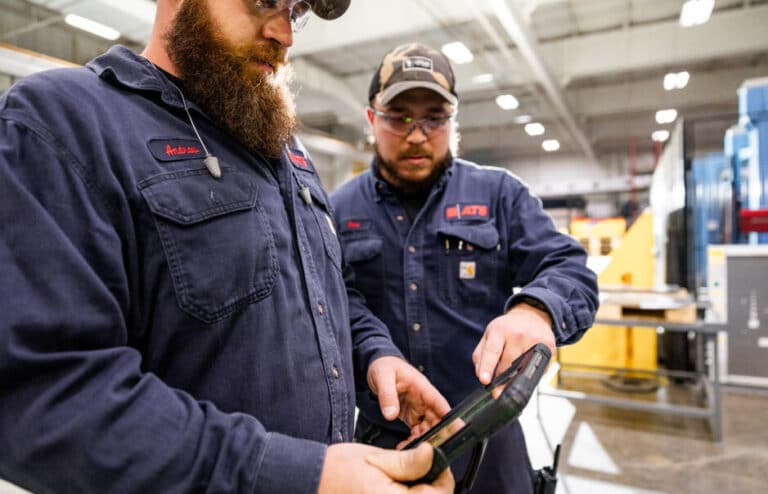Most manufacturing processes are extremely complex, and there are many ways in which things can go wrong. PFMEA is a structured process for identifying risks and defining and prioritizing preventive actions. Manufacturers use it proactively to avoid unplanned machine downtime, maintain consistent levels of quality and prevent accidents.
After introducing the methodology, this blog discusses when and how it should be followed. The major benefits are identified so readers can determine whether PFMEA is something they want to use.
What is PFMEA?
Process Failure Mode and Effects Analysis (PFMEA) is a version of FMEA tailored for use with manufacturing processes. FMEA is a methodology for determining the likelihood and impact of a particular event. Based mainly on expert opinions, it provides a structured method of identifying priorities for improvement, remediation or preventive actions.
PFMEA in manufacturing supports plant maintenance operations by identifying priorities for servicing and repair. To give an example, in many factories, the air compressor is a vital piece of equipment. While the risk of breakdown is probably low, the consequences can be severe. PFMEA could be used to determine the most probable causes of failure and, from there, to develop preventive actions.
How does PFMEA work?
The idea is to identify all possible failure modes for a process, line or piece of equipment. For each mode identified a “Risk Priority Number” (RPN) is calculated. This is the product of values for severity, probability of occurrence, and difficulty of detection before the event has an impact. Typically, these are estimated on a 1-10 scale, with larger numbers signifying greater risk.
Management then tasks teams or functions with developing and executing actions to prevent occurrence of events with the highest RPNs.
PFMEA can be applied to existing, new, or proposed processes and equipment. Where equipment is already in place, data may be available to quantify probabilities of events, and their impact. More often though, the failure mode analysis process is performed before any history exists. In this case, numerical values are estimated by individuals or groups with detailed knowledge of the process.
When to perform PFMEA
Given that the goal of PFMEA is to prevent costly breakdowns or other failures, it should be performed:
- During process design: When determining or developing a new manufacturing process, a PFMA helps identify areas of risk, so appropriate controls and standard operating procedures (SOPs) can be implemented. Adhesive bonding and welding processes are examples where it’s important to establish control over quality-related variables.
- Prior to process startup: Performing a PFMEA at this point can support the maintenance team in developing appropriate preventive maintenance strategies. It may also be required by a customer looking for increased confidence in supply continuity.
- When planning extensive process modifications: Whenever equipment or materials are changed, there is a risk of unintended consequences. Performing a PFMEA ensures any new or changed equipment servicing needs are identified and incorporated into the maintenance schedules.
Other times, a PFMEA can be useful as part of an investigation into quality problems, when developing a preventive maintenance strategy, and in response to an accident. In these situations, it’s common to supplement PFMEA with the “Five Whys” technique to determine root causes.
How to conduct a PFMEA
Preliminary steps prior to initiating a PFMEA in manufacturing are to define the target area, the goals or objectives, and to form a team. The team should be made of people familiar with the product or products and the manufacturing process. It’s also useful to include a representative from maintenance who is familiar with the machinery or equipment in the target area.
Once the team has been formed and briefed, it’s time to execute the following failure mode and effects analysis steps:
1. Conduct a detailed process review: This is usually done in the form of a flow chart showing the process inputs (such as raw materials) and outputs (such as the finished product). It gives all the team members a common understanding of the process under review.
2. Identify failure modes: This can take the form of a brainstorming exercise with team members asking questions and offering ideas.
An initial briefing at the outset is often helpful in reminding the team of the five failure modes to consider:
- Complete breakdown: Where the process fails or is not performed.
- Partial breakdown: Part of the equipment or process isn’t working as it should, but can be made to achieve the required result. For example, the heater in a drying oven may not be working at 100%, but an additional unit can be brought in on a temporary basis.
- Intermittent or microstoppages: Often self-correcting, such as a fuse that trips and resets, this type of failure is disruptive and can harm product quality.
- Reduced performance: Where a machine is run at a lower speed because full speed operation causes quality losses or other problems.
- Supply disruptions: Non-availability of raw material is the most obvious example, but this could also include what happens when a manufacturing or maintenance team member with unique skills doesn’t show up for work.
3. Identify the effects of each failure: Will it bring production to a halt? Could it increase product variability? Might it require additional labor?
4. Assign a ranking to the severity of each failure mode: Typically done on a 1-10 scale, with 1 the least impactful.
5. Assign a ranking for probability of occurrence: Again, use a 1–10 scale. Remember to use historical data as a guide, if any is available.
6. Assign detection difficulty rankings: This refers to the probability of detecting, and therefore being able to act on, the failure. A complete stoppage of a production is probably easy to see whereas insufficient surface cleaning prior to bonding may not be detectable. Here, the former gets a ranking of 1 while the latter might be considered a 10.
7. Calculate the RPN: Multiply the severity, occurrence and detection scores, and rank failure modes accordingly.
8. Develop an action plan: The RPN ranking will show which faults pose the highest risk to production. Management should develop plans to mitigate these failure modes. These often include:
- Writing SOPs to reduce variability in how work is done
- Implementing measurement and alarm systems, for example, to measure concentrations and flows of cleaning agents
- Developing preventive maintenance schedules
- Implementing condition monitoring systems
Following a Plan-Do-Check-Act philosophy, the PFMEA should be repeated once the action plan has been fully implemented.
Benefits of PFMEA
While a thorough PFMEA takes time to plan and requires considerable resources to carry out and follow up on, it helps a business avoid unexpected costs and disruption. More specifically, the benefits of a PFMEA include:
- Prevents equipment and process failures: This avoids disruptions to delivery schedules, quality problems, and the associated additional labor and material costs.
- Provides a basis for process control planning: Only when risks are identified is it possible to develop procedures to guard against them.
- Reduced customer risk: Products with hidden defects, such as poor quality welds or faulty adhesive application, can fail in service. PFMEA identifies these risks and helps define preventive measures.
- Increased safety: A thorough PFMEA will cover accident risks, with the action plan identifying steps needed to improve worker safety.
- Lower costs: Reduced accidents and warranty claims, fewer breakdowns and higher yields all lead to lower costs and higher margins.
Industrial asset management with ATS
Manufacturers use PFMEA as a proactive process for identifying risks, and defining and prioritizing preventive actions. It guides maintenance planners in reducing unplanned machine downtime, helps maintain consistent levels of quality, and prevents accidents.
As leaders in all aspects of industrial maintenance, ATS understands the value of a well-organized PFMEA. We help manufacturers increase maintenance effectiveness, driving waste out and costs down while increasing OEE and capacity. Contact us to learn more.


